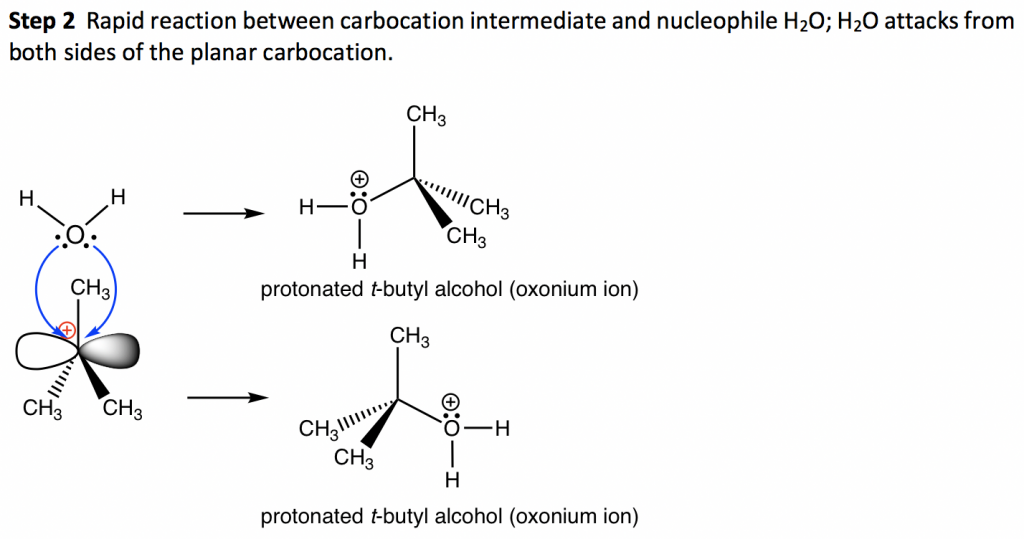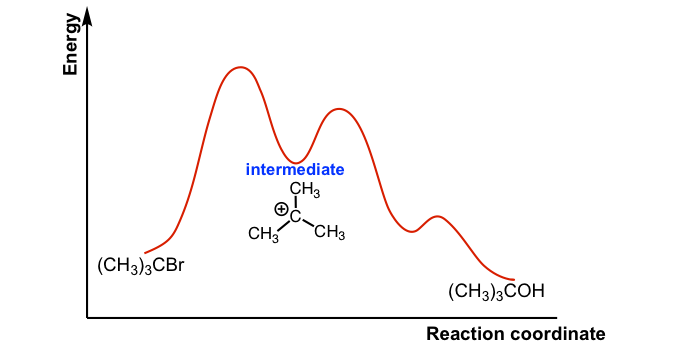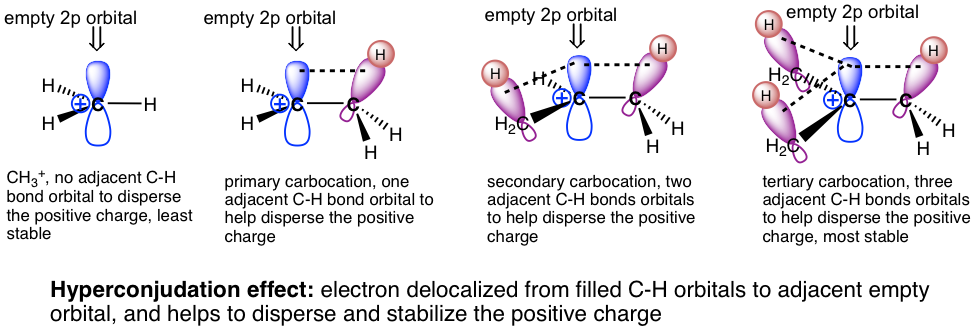7.4: SN1 Reaction Mechanism, Energy Diagram and Stereochemistry
- Page ID
- 359606
\( \newcommand{\vecs}[1]{\overset { \scriptstyle \rightharpoonup} {\mathbf{#1}} } \)
\( \newcommand{\vecd}[1]{\overset{-\!-\!\rightharpoonup}{\vphantom{a}\smash {#1}}} \)
\( \newcommand{\id}{\mathrm{id}}\) \( \newcommand{\Span}{\mathrm{span}}\)
( \newcommand{\kernel}{\mathrm{null}\,}\) \( \newcommand{\range}{\mathrm{range}\,}\)
\( \newcommand{\RealPart}{\mathrm{Re}}\) \( \newcommand{\ImaginaryPart}{\mathrm{Im}}\)
\( \newcommand{\Argument}{\mathrm{Arg}}\) \( \newcommand{\norm}[1]{\| #1 \|}\)
\( \newcommand{\inner}[2]{\langle #1, #2 \rangle}\)
\( \newcommand{\Span}{\mathrm{span}}\)
\( \newcommand{\id}{\mathrm{id}}\)
\( \newcommand{\Span}{\mathrm{span}}\)
\( \newcommand{\kernel}{\mathrm{null}\,}\)
\( \newcommand{\range}{\mathrm{range}\,}\)
\( \newcommand{\RealPart}{\mathrm{Re}}\)
\( \newcommand{\ImaginaryPart}{\mathrm{Im}}\)
\( \newcommand{\Argument}{\mathrm{Arg}}\)
\( \newcommand{\norm}[1]{\| #1 \|}\)
\( \newcommand{\inner}[2]{\langle #1, #2 \rangle}\)
\( \newcommand{\Span}{\mathrm{span}}\) \( \newcommand{\AA}{\unicode[.8,0]{x212B}}\)
\( \newcommand{\vectorA}[1]{\vec{#1}} % arrow\)
\( \newcommand{\vectorAt}[1]{\vec{\text{#1}}} % arrow\)
\( \newcommand{\vectorB}[1]{\overset { \scriptstyle \rightharpoonup} {\mathbf{#1}} } \)
\( \newcommand{\vectorC}[1]{\textbf{#1}} \)
\( \newcommand{\vectorD}[1]{\overrightarrow{#1}} \)
\( \newcommand{\vectorDt}[1]{\overrightarrow{\text{#1}}} \)
\( \newcommand{\vectE}[1]{\overset{-\!-\!\rightharpoonup}{\vphantom{a}\smash{\mathbf {#1}}}} \)
\( \newcommand{\vecs}[1]{\overset { \scriptstyle \rightharpoonup} {\mathbf{#1}} } \)
\( \newcommand{\vecd}[1]{\overset{-\!-\!\rightharpoonup}{\vphantom{a}\smash {#1}}} \)
\(\newcommand{\avec}{\mathbf a}\) \(\newcommand{\bvec}{\mathbf b}\) \(\newcommand{\cvec}{\mathbf c}\) \(\newcommand{\dvec}{\mathbf d}\) \(\newcommand{\dtil}{\widetilde{\mathbf d}}\) \(\newcommand{\evec}{\mathbf e}\) \(\newcommand{\fvec}{\mathbf f}\) \(\newcommand{\nvec}{\mathbf n}\) \(\newcommand{\pvec}{\mathbf p}\) \(\newcommand{\qvec}{\mathbf q}\) \(\newcommand{\svec}{\mathbf s}\) \(\newcommand{\tvec}{\mathbf t}\) \(\newcommand{\uvec}{\mathbf u}\) \(\newcommand{\vvec}{\mathbf v}\) \(\newcommand{\wvec}{\mathbf w}\) \(\newcommand{\xvec}{\mathbf x}\) \(\newcommand{\yvec}{\mathbf y}\) \(\newcommand{\zvec}{\mathbf z}\) \(\newcommand{\rvec}{\mathbf r}\) \(\newcommand{\mvec}{\mathbf m}\) \(\newcommand{\zerovec}{\mathbf 0}\) \(\newcommand{\onevec}{\mathbf 1}\) \(\newcommand{\real}{\mathbb R}\) \(\newcommand{\twovec}[2]{\left[\begin{array}{r}#1 \\ #2 \end{array}\right]}\) \(\newcommand{\ctwovec}[2]{\left[\begin{array}{c}#1 \\ #2 \end{array}\right]}\) \(\newcommand{\threevec}[3]{\left[\begin{array}{r}#1 \\ #2 \\ #3 \end{array}\right]}\) \(\newcommand{\cthreevec}[3]{\left[\begin{array}{c}#1 \\ #2 \\ #3 \end{array}\right]}\) \(\newcommand{\fourvec}[4]{\left[\begin{array}{r}#1 \\ #2 \\ #3 \\ #4 \end{array}\right]}\) \(\newcommand{\cfourvec}[4]{\left[\begin{array}{c}#1 \\ #2 \\ #3 \\ #4 \end{array}\right]}\) \(\newcommand{\fivevec}[5]{\left[\begin{array}{r}#1 \\ #2 \\ #3 \\ #4 \\ #5 \\ \end{array}\right]}\) \(\newcommand{\cfivevec}[5]{\left[\begin{array}{c}#1 \\ #2 \\ #3 \\ #4 \\ #5 \\ \end{array}\right]}\) \(\newcommand{\mattwo}[4]{\left[\begin{array}{rr}#1 \amp #2 \\ #3 \amp #4 \\ \end{array}\right]}\) \(\newcommand{\laspan}[1]{\text{Span}\{#1\}}\) \(\newcommand{\bcal}{\cal B}\) \(\newcommand{\ccal}{\cal C}\) \(\newcommand{\scal}{\cal S}\) \(\newcommand{\wcal}{\cal W}\) \(\newcommand{\ecal}{\cal E}\) \(\newcommand{\coords}[2]{\left\{#1\right\}_{#2}}\) \(\newcommand{\gray}[1]{\color{gray}{#1}}\) \(\newcommand{\lgray}[1]{\color{lightgray}{#1}}\) \(\newcommand{\rank}{\operatorname{rank}}\) \(\newcommand{\row}{\text{Row}}\) \(\newcommand{\col}{\text{Col}}\) \(\renewcommand{\row}{\text{Row}}\) \(\newcommand{\nul}{\text{Nul}}\) \(\newcommand{\var}{\text{Var}}\) \(\newcommand{\corr}{\text{corr}}\) \(\newcommand{\len}[1]{\left|#1\right|}\) \(\newcommand{\bbar}{\overline{\bvec}}\) \(\newcommand{\bhat}{\widehat{\bvec}}\) \(\newcommand{\bperp}{\bvec^\perp}\) \(\newcommand{\xhat}{\widehat{\xvec}}\) \(\newcommand{\vhat}{\widehat{\vvec}}\) \(\newcommand{\uhat}{\widehat{\uvec}}\) \(\newcommand{\what}{\widehat{\wvec}}\) \(\newcommand{\Sighat}{\widehat{\Sigma}}\) \(\newcommand{\lt}{<}\) \(\newcommand{\gt}{>}\) \(\newcommand{\amp}{&}\) \(\definecolor{fillinmathshade}{gray}{0.9}\)SN1 Reaction Mechanism
The reaction between tert-butylbromide and water proceeds via the SN1 mechanism. Unlike SN2 that is a single-step reaction, SN1 reaction involves multiple steps. Reaction: (CH3)3CBr + H2O → (CH3)3COH + HBr



In step 1, C—Br bond breaks and Br departs with the bonding electron pair to produce a tertiary carbocation and bromide anion Br–. This step only involves a highly endothermic bond-breaking process, and this is the slowest step in the whole mechanism. In multiple-step mechanism, the overall reaction rate is determined by the slowest step, such step is therefore called the rate-determining step. In SN1 reaction, step 1 is the slowest step and therefore the rate-determining step. The rate-determining step only involves the alkyl halide substrate, that is why the overall rate law is in first order, because nucleophile does not participate in the rate-determining step.
The product of step 1, carbocation, will be the reactant of next step and is called the intermediate for SN1 reaction. Intermediate is the unstable, highly-reactive species with very short lifetime. The carbocation intermediate is in trigonal planar shape, with the empty 2p orbital particular to the plane. The central carbon is sp2 hybridized and has the incomplete octet, so carbocation is the highly reactive intermediate, that is also the electrophile.
Step 2 is the nucleophilic attack step, that the nucleophile H2O use its lone pair to react with the carbocation intermediate, and produces the protonated t-butyl alcohol (oxonium ion). Because of the planar shape of carbocation intermediate, there is same possibility for the nucleophile to attack from either side of the plane, so possible products are generated with the same amounts. For this reaction, attacking from either side gives the same product (both are still shown for the purpose to illustrate the concept); however it gives different stereoisomers if the electrophilic carbon is the chirality center. In step 3, a water molecule acting as a Bronsted base to accept the proton from the oxonium ion, and the final neutral product t-butyl alcohol is produced. This deprotonation step is very fast, and sometimes can be combined with step 2 together as one step (i.e. step 3 may not be regarded as an individual step).Energy diagram of SN1 mechanism
Because SN1 is a multiple-step reaction, so the diagram has multiple curves, with each step can be represented by one curve. Out of the three steps, the activation energy for step 1 is the highest, therefore step 1 is the slowest step, that is the rate-determining step.

The connection between the first two curves represent the carbocation intermediate. Generally, intermediate is the product of one step of a reaction and the reactant for the next step. Intermediate is at a relatively lower energy level comparing to transition state (which is at the peak of a curve), but intermediate is also highly reactive and unstable.
The Effect of Substrate Structure on SN1 Reaction Rate
Different substrates have different reaction rates towards SN1 reaction, and the relative reactivity of substrates towards SN1 reaction can be summarized as:

Comparing this trend to that for SN2 reaction, you probably realize that they are just opposite. Tertiary substrate is most reactive towards SN1, but it does not undergo SN2 at all; primary and methyl substrate are unreactive for SN1, but they are the best substrates for SN2. This comparison is very important and useful for us to choose the proper reaction condition for different substrate as we will see in next section. For now, we will need to understand the reasoning of the trend for SN1.
This is because of the stability of carbocation intermediate. The mechanism shows that a carbocation is formed in the rate-determining step, so the more stable the carbocation, the more easily it is formed, the more it facilitates the rate-determining step and speed up the whole reaction. Therefore the more stable the carbocation intermediate is, the faster the rate of a SN1 reaction.
The relative stability of carbocation is given below, that the tertiary carbocations are the most stable and methyl carbocation is the least stable.

The relative stability of carbocations can be explained by the hyperconjugation effect. Hyperconjugation is the partial orbital overlap between filled bonding orbital to an adjacent unfilled (or half-filled) orbital. Carbocation is the electron-deficient species that has the incomplete octet and empty 2p orbital. If there is an alkyl group connected with carbocation, then there are C-C or C-H sigma bonds beside the carbocation carbon, so the filled orbitals of sigma bonds will be able to partially overlap with the empty 2p orbital, therefore sharing the electron density to carbocation and to get the carbocation stabilized. The more R group involved, the stronger hyperconjugation effect is. So tertiary (3°) carbocation is the most stable one. While there is no any R group in methyl carbocation, CH3+, it is least stable.

Stereochemistry of SN1 mechanism
The stereochemistry feature of the SN1 reaction is very different to that of SN2, and of course can be explained well with the SN1 mechanism.

Starting with (S)-3-bromo-3-methylhexane reactant, the SN1 reaction produces a 50:50 mixture of both R and S enantiomers of 3-methyl-3-hexanol, that is the racemic mixture product. This is because the carbocation formed in the first step of an SN1 reaction has the trigonal planar shape, when it react with nucleophile, it may react from either the front side or the back side, and each side gives one enantiomer. There is equal possibility for reaction to occur from either side, so the two enantiomers are formed with the same amount, and the product is a racemic mixture.
A reaction that coverts an optically active compound into a racemic form is said to proceed with racemization. For SN1 reaction that start with (an optical active)one enantiomer as the reactant, and the chirality center is also the electrophilic carbon (i.e. the reaction occurs on the chirality center), it proceeds with racemization as shown above.
Exercises 7.3
Show the detailed mechanism for above reaction of (S)-3-bromo-3-methylhexane and water.
Answers to Practice Questions Chapter 7
Please note that if the chirality center of the reactant is not the reaction center, or if there are more than one chirality center in the reactant, the SN1 reaction does not produce the racemic mixture as example below.
Examples
Show product(s) of the following SN1 reaction:

Solution:

L eaving Group Effect on SN1
Same as for SN2 reaction, a good leaving group is also required for SN1 mechanism, and all the discussions we had before in section 7.3 apply.
Nucleophile
Unlike a SN2 reaction, the rate-determining step of SN1 reaction does not include nucleophile, so theoretically the strength of nucleophile has no effect on SN1 reaction. However, a strong nucleophile has high tendency to go with SN2 reaction instead of SN1, so a weaker nucleophile is a better choice for SN1. For the examples we had so far, H2O is the nucleophile.
In practice, neutral substances such as H2O, ROH, RCOOH are usually used as nucleophiles in SN1 reaction. When these substances are applied in the reaction, they serve for another function as solvents. So they are used as both nucleophiles and solvents for SN1 reaction, and such reaction is also called the solvolysis reaction. Solvolysis reaction is a nucleophilic substitution in which the nucleophile is a molecule of solvent as well. The term solvolysis comes from: solvent+lysis, that means cleavage by the solvent. A SN1 reaction is usually a solvolysis reaction.
Examples
 Solution:
Solution:



